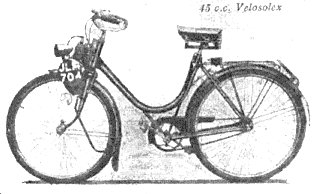 Go
to the Archive index
Go
to the Archive indexIn comparison with machines such as the Cyclemaster and the New Hudson autocycle, preserved VéloSolexes are rare in Britain and a good proportion of these surviving machines have been imported from France by enthusiasts. The VéloSoleX is the second most popular motor cycle of all time so why is it so scarce here?
British acquaintance with the VéloSoleX began in July 1946 when the motor cycling press announced a new "French Power-cycle". At this time the machine was known simply as the "Solex". The 1946 Solex had a drop frame with a main tube of 1¾ inch diameter. The 45cc engine was mounted above the front wheel, which it drove via a roller. The engine developed two-thirds of a horse power at 2000rpm. With the engine running at 1000rpm the speed was 6.2mph, and the maximum speed was 17mph. The Solex was fitted with a drum brake on the rear wheel and a cord skirt-guard. The wheels were retained by large wing-nuts and the pedals were of the 'rat trap' variety. The Solex was not yet commercially available in Britain.

It was not until March 1948 that "The Motor Cycle" published a road test of the "VéloSoleX"—as it was now known. The test machine, registered JLM 704, was an import from France and was different from the 1946 model in several ways. The diameter of the main frame tube had been reduced by an eighth of an inch and details of the frame construction had been altered to reduce manufacturing costs. The engine was basically the same, although there were detail changes to the cylinder head, fuel pump and air filter. The skirt-guard had gone as had the wing nuts. Both brakes were now callipers. These brakes were worked from inverted levers, whereas the 1946 machine had normal levers. This test machine was also fitted, somewhat illegally, with a bell. In March 1949 the VéloSoleX became available in Britain. The machines were assembled in Britain—partly from imported French parts and partly from British components. It was anticipated that eventually all the parts would be manufactured in Britain. The price of a VéloSoleX was £34 14s 10d but with the addition of £10 5s 2d purchase tax this increased to a round £45.
The use of British components resulted in more detail changes. The main British parts used were readily available cycle parts such as tyres, saddle, lamps, pedals, chain-wheel, etc. The British headlamp was fitted to a normal lamp bracket on the steering head—French machines had the lamp attached to the magneto back-plate—and the pedals now had rubber grips. A bulb horn replaced the bell to comply with British law.
With over 30,000 VéloSoleXes already on the road in France things looked to be set fair for a similar success here—but this was not to be. In France, the VéloSoleX was a cheap, basic machine. It required no mechanical knowledge from its owner, and very little in the way of legal formalities. However, in Britain the situation was somewhat different. The VéloSoleX was subject to all the licensing requirements of a motor cycle and it was expensive. It was sold as a complete machine and, therefore, was subject to purchase tax. A cyclemotor, bought separately and then attached to a bicycle did not attract purchase tax and could be had for little more than half the price of a VéloSoleX. A prospective purchaser with the £45 to buy a VéloSoleX could for a few pounds more buy a cheap autocycle which, with its 100cc engine and spring forks, would give a more comfortable ride at twice the speed of the VéloSoleX. And as far as legal requirements were concerned there was no difference between the VéloSoleX and the autocycle.
In the end, Solex gave up on the British market. Whilst improvements were made to the machines available abroad, including a new pressed steel frame and a new 49cc engine, these changes were not introduced in this country. Britain plodded on with the same old machines. Any improvements on the 1949 design only concerned minor details. Solex did try to exert some pressure to get British law brought more into line with that on the Continent, but it was to no avail and British production of the VéloSoleX stopped in 1957.
Any article on the VéloSoleX would be incomplete without a mention of its fuel system. The float-less carburettor was a major feature in the VéloSoleX's appeal to the non-mechanically minded. A fuel pump driven by crankcase pressure variations raised the petrol to the carburettor. The petrol was supplied faster than the engine could burn it, so the excess ran back to the tank down an overflow pipe, thus maintaining a constant fuel level in the carburettor. The throttle was worked by a trigger lever on the handlebars. The throttle was normally wide open, pulling the trigger first closed the throttle and then opened the decompressor.
To start the machine you pulled in the trigger, pedalled off, then let the trigger go. From then on you could forget the throttle control until you wanted to stop. It was just like riding a bike but without the effort. You didn't even have to remember to turn a fuel tap on!
First published - October 1997